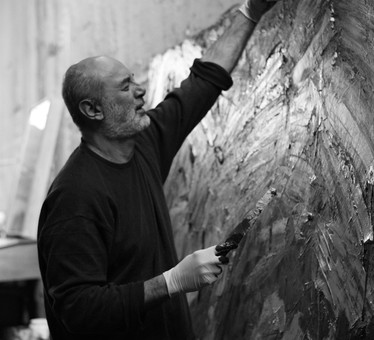Fluteless Bread - Cabral

São Paulo, Brasil
26/10/2024 - 08/03/2025
Dan Galeria presents an excerpt of new paintings from Antonio Hélio Cabral’s vast language repertoire. In addition to the exhibition, the gallery also announces the artist’s representation.
When, in 1970, Cabral began attending the School of Architecture and Urbanism of the University of São Paulo (FAUUSP), the night sky of São Paulo had already loosened its constellations, and the lights of his studio, little by little, were imposed on the young artist. Sculptures, objects, paintings, drawings, engravings, texts, took turns as a tool and constituent material. His many phases, always driven by interests in various fields of study, served as the foundation for future processes and projects. In this way, it is understood that Cabral’s work consolidated views, subjects, and techniques, associating them in an original and profound way, following an expressive path. To him everything speaks to everything. The trait itself is design and can embody movement, gesture, dance. Rhythm, timbre, music and even, through the calibration of power, create chromatic and psychic analogies. The title of the exhibition refers to one of the works on display — Bread Without Flute from 2023, oil on canvas, 160 × 120 cm. Today, with sixty years of experience, the artist’s work emerges and is present in private and institutional collections in Brazil and abroad.
____________
I think of the figure as derived from painting. The painted figure, however, is everything I don’t want. In the case of drawing, solve for me the figure that comes from the line, which is born from the line. It would be better if, after the act of painting or tracing, we could say that there is a coincidence between figure and painting, line and figure, as if they were commutable subject and predicate: the painting that is a figure, the figure that is a trait
.
So, what can figure painting provide when looking? If the perceived must not be broken up and what is understood is not pure understanding, one cannot separate color from form, the act of painting from painting, the trace from the trace. I believe that the gaze is a way of being, that the painting is not there to designate the image, that the painting is not at the service of the representation of the cat, of the landscape, of the table; instead, it gives rise to possible ghosts that emerge at the intersection between
the painting and the eye.
The figure has always been, for me, an object of reflection. Since the first drawings in 1970, I have tried to empty the figurative, getting rid of the flat shapes that result from it, deviating from the obvious inherent in its structure. In the 1980s, when I was fully involved with observational painting, I realized that one of the impediments of figure-painting was the discontinuity between background and form, since separation privileged the figurative framework, while the tension between the figure and what is outside it favors
painting.
I carried this tension until it crossed the figure’s arms, causing a kind of avalanche from the bottom on it, thus establishing another plastic space, a space that began to expel figures that emerged from other figures. This passage from painting to the figure is divided by me into two distinct stages, namely, the removal of the clamps and the avalanche, since each of them leads to its own painting. The possibility of creation is tied to the unique. This is how all art supports its own originality, and cannot be relativised in technique or poetics. Existence is against the grain — it’s impossible to negotiate within its framework. ANTONIO HELIO CABRAL
“Antonio Hélio Cabral who is, without a doubt, one of the most original expressionist artists we know. In Cabral, there is a search for transcendence in which the figure, which is the foundation of his play, of his work, undergoes an uninterrupted process of transformation, refiguration and reformulation. This appears in the intensity of the pictorial mass with which he works, with the volume of ink with which he works, with the intensity of the color with which he elaborates his figuration. It is a constant uninterrupted transformation as human life is, as the human being normally is.” Peter Cohn